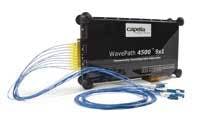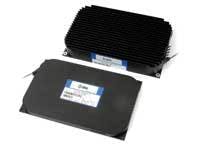There are two prevailing myths surrounding the ROADM component market today, says Thomas Dudley, president and chief executive officer of Xtellus (www.xtellus.com). The first is the myth that metro applications are driving ROADM growth. According to Dudley, Xtellus’s revenue predominantly is coming from wavelength blockers for long-haul applications-a fact that recent Infonetics Research numbers corroborate. In 2005, worldwide sales of long-haul ROADM-enabled gear edged out metro gear at $392 million. But metro gear did not lag far behind, tallying sales of $263 million.
Dudley believes the second biggest myth surrounding the ROADM component market is the misconception that WSSs are taking over from blockers, which were available and were deployed first. Not true, he says, adding that Xtellus will have shipped “well in excess” of 500 wavelength blockers by the end of this year. “One of the things that new entrants always miscalculate with respect to a market is they always sort of point to incumbent technology as something that is standing still, both in terms of capability and in terms of price, while at the same time they are coming to market with something new,” says Jonathan Homa, vice president of sales and marketing for Xtellus. “We are also coming to market with a WSS, but at the same time, the incumbent technology, such as the wavelength blocker in this particular case, will continue to decline in price and add performance commensurate with that price.”
For their part, the folks at JDSU (www.jdsu.com) argue that the transition from wavelength blocker technology to WSS technology already has begun. JDSU is the market leader in wavelength blocker components, yet “we have actually shipped fewer wavelength blockers now in total than the new generation 2D [two-degree ROADMs] or from 2D to 8D WSSs,” reports Jy Bhardwaj, general manager of JDSU’s Agile Optical Networks Business Unit. In fact, Bhardwaj confirms that JDSU’s 1×9 WSS and 2D PLC ROADM constitute more than 90% of the ROADM components JDSU is shipping for metro applications today.Ken Falta, vice president of sales and marketing at Capella Photonics (www.capellainc.com), also is bullish on WSS technology. While he agrees that wavelength blockers still may dominate the market from a deployment perspective, “all new development activity is WSS-based,” he says. “Everything seems to be about scalability and flexibility from the network side. As traffic moves to IP and video and the network’s growth becomes unpredictable, just being able to get any wavelength to any port and scale to mesh and higher-degree nodes seems to be driving demand for WSS,” he adds.
There are three primary technologies used to develop ROADM elements today: microelectromechanical systems (MEMS), liquid crystal, and PLC technology. Among the carrier community, however, the technology itself is almost irrelevant; it is simply a means to an end-cost-effectiveness.
“The customers really want to look at the module component vendors as black-box solution providers,” admits Bhardwaj. “No one really wants to delve into the technology, other than understanding, ‘Is this a qualified technology that is going to work? Do you have volume-manufacturing capability? Will you be able to make this product for me in a couple of years’ time in volume and at the [right] price points?’ That is the level of understanding that they want,” he says.
Stewart Elby, vice president of network architecture and enterprise technologies at Verizon (www.verizon.com), confirms that it is largely a price/performance decision. “Because of traffic demand or the way I’m building out the FTTP network, for instance, I want to start with a four [degree ROADM], then move to a six and an eight. So it has to do with which technology gives me a better migration path,” he muses. “The other areas of performance aren’t simply how it performs in terms of its loss and its performance in terms of speed of switching; it’s also about lifecycle. This is pretty new technology-all of them are, except maybe liquid crystal, which is the most mature. So that’s an issue as well. Which one is going to stand up best over a long period of time? We do look at the technology,” he says, “but in the end, we’re really looking for what’s going to give us the best price for the performance.”
Mark Feuer, senior technical specialist at AT&T Labs (www.att.com/attlabs/), admits that while his department does evaluate various technologies, “AT&T is really technology agnostic. We buy what works and what has the highest functionality,” he says, noting that today’s vendors are starting to provide both blockers and WSSs with high functionality and solid performance specifications.
“I won’t take sides on which of those should be used,” Feuer says, “but I think you will see that those with high performance are going to continue to succeed in the market. The performance, in terms of optical bandwidth and loss, has to be pretty high, and that applies to both metro and long haul because you end up cascading a lot of nodes,” he explains. “A given light signal may pass through a lot of nodes to get where it’s going, and then each node has to be very, very good. But we are seeing the component vendors doing that, so we’re excited.”
“In other words,” says Pete Magill, director of AT&T Labs, “a lot of it comes down to what happens when you build a big network and you are scaling to those large numbers of nodes. It’s not the same thing as if you just built one node by itself, so these detailed performance issues are pretty important.”
Bhardwaj cautions that it is important to consider the network itself. Today’s carriers are moving toward mesh networks and ring interconnectivity, which require a greater amount of flexibility. Such agile optical networks also require future-proofing, “which has a cost element associated with it,” he says. “Nothing comes for free.”
When carriers build out this more complex network architecture, they will likely have a combination of two-degree nodes all the way up to eight-degree and greater nodes, says Bhardwaj, and they will, therefore, deploy a range of products. “There is a real need in the market today for cost-effective solutions. For nodes that are 2D and people do not see the need to grow above 2D, they want a cost-effective solution for 2D, and they don’t want to spend any more money than they have to,” he explains. “Similarly, for 3D to 4D, they want the most cost-effective solution for 3D to 4D. And they want the most cost-effective solution for 8D. That really allows us to sit back and say, ‘What is the best range of products we can offer into this market to meet this cost need?’”
While there are several misconceptions about the ROADM component market, notes Homa, the most glaring may be that people assume the price of WSSs will decline so dramatically, they will be implemented ubiquitously throughout the network, whether they are really needed or not. This is simply not so, says Homa.
“WSS is and always will be more expensive than an equivalent wavelength blocker for two reasons,” he contends. “First, the wavelength blocker is an incumbent technology. As a result, it always has the ability to ride down the price curve well ahead of newer technology. Second, [WSS] is much more complex from an assembly point of view for the active alignment and attachment to the various parts, and it requires more time for the testing of the device.”
As such, carriers are going to deploy the technology that makes the most sense for a particular node based on the cost and performance requirements of that node. They are not going to pay a premium for something they don’t need, says Homa.
On this point, Bhardwaj agrees. Say you’re going to deploy a WSS at a particular node. That node would comprise not only the WSS but also any additional multiplexing/demultiplexing-plus power monitoring, which is critical, he says. “If you want the capability of dropping, let’s say, four to five wavelengths at a particular port, and you want 3D mesh capability, now you’re looking at an 8D ROADM. That is going to provide you with four to five drops, which are colorless, but if you want eight drops and you want mesh capability, how are you going to do it? Now you have to have a second WSS. Or you’re going to have to have additional muxing and demuxing.
“The full picture that we need to take into account determines, really, to what degree the carriers want to spend money to future-proof their nodes and to have that capability built in day one,” says Bhardwaj. “Or to what degree they want to have the flexibility to add additional hardware later on to provide that upgradeability. This is the delicate balance between capex and opex.”
The net result is that there isn’t one specific component on the market today that meets all price/performance/functionality needs. Instead, component and system vendors are left to ponder the best range of products they can offer the carriers to satisfy various performance needs and price points.
